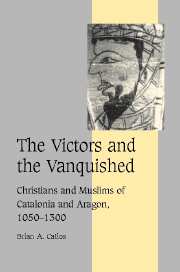Book contents
- Frontmatter
- Contents
- List of figures
- List of maps
- List of tables
- Acknowledgments
- Note on the citation of sources, dates, places, and names
- Glossary
- List of abbreviations
- INTRODUCTION
- Part I Muslim domination of the Ebro and its demise, 700–1200
- Part II Muslims under Christian rule
- INTRODUCTION
- 3 THE FINANCIAL AND JUDICIAL ADMINISTRATION OF MUDÉJAR SOCIETY
- 4 MUSLIMS IN THE ECONOMY OF THE CHRISTIAN EBRO
- 5 MUDÉJAR ETHNICITY AND CHRISTIAN SOCIETY
- 6 MUSLIMS AND CHRISTIAN SOCIETY
- MUDEJARISMO AS A SOCIAL SYSTEM
- Part III INDIVIDUAL AND COMMUNITY IN THE CHRISTIAN EBRO
- Conclusions
- Appendices
- Select bibliography
- Index
- Cambridge Studies in Medieval Life and Thought Fourth series
5 - MUDÉJAR ETHNICITY AND CHRISTIAN SOCIETY
Published online by Cambridge University Press: 08 January 2010
- Frontmatter
- Contents
- List of figures
- List of maps
- List of tables
- Acknowledgments
- Note on the citation of sources, dates, places, and names
- Glossary
- List of abbreviations
- INTRODUCTION
- Part I Muslim domination of the Ebro and its demise, 700–1200
- Part II Muslims under Christian rule
- INTRODUCTION
- 3 THE FINANCIAL AND JUDICIAL ADMINISTRATION OF MUDÉJAR SOCIETY
- 4 MUSLIMS IN THE ECONOMY OF THE CHRISTIAN EBRO
- 5 MUDÉJAR ETHNICITY AND CHRISTIAN SOCIETY
- 6 MUSLIMS AND CHRISTIAN SOCIETY
- MUDEJARISMO AS A SOCIAL SYSTEM
- Part III INDIVIDUAL AND COMMUNITY IN THE CHRISTIAN EBRO
- Conclusions
- Appendices
- Select bibliography
- Index
- Cambridge Studies in Medieval Life and Thought Fourth series
Summary
Whereas the last two chapters dealt with the administrative and economic structures of mudéjar society in the Ebro region, the present and following chapters examine the social situation of Muslims living under Christian rule. Governmental and commercial norms can be apprehended fairly directly from the documents, but social structures and dynamics tend to be rather more subtle in manifestation and are not, for the most part, described explicitly. This bias of the sources, coupled with the tendency for “Western” observers to idealize Islamic society, have discouraged inquiry into mudéjar ethnicity and discouraged historians from making adequate distinctions between group and individual identity in referring to Muslims under Christian rule.
The present chapter focuses on what may be called “internal” and “external” structural manifestations of mudéjar ethnicity. The internal structures relate to social divisions within the Muslim population, which was anything but an undifferentiated mass of disadvantaged and passive subjects. The documents permit the historian to discern two groups that stand apart from the bulk of mudéjar society, an upper class and slaves, although the actual situation was undoubtedly more variegated. The upper class is not mentioned as such in the contemporary sources, and slaves tend to be thought of as occupying a place completely outside of mudéjar society, yet each of the two groups played a integral role in shaping the mudéjar experience. Next, language and religion – the most visible manifestations of mudéjar ethnicity aside – are addressed.
- Type
- Chapter
- Information
- The Victors and the VanquishedChristians and Muslims of Catalonia and Aragon, 1050–1300, pp. 213 - 260Publisher: Cambridge University PressPrint publication year: 2004



